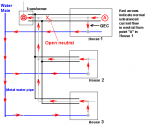Bro8898
Member
- Location
- Birmingham, AL
- Occupation
- Master Plumber
Hey guys. I’m new here. I’m a master plumber from bham al and looking for some advice on metal water pipes. I’ve searched plumbing forums high and low for answers and cannot find what I’m looking for. Any advice would be greatly appreciated.
I understand a little about the difference between grounding and bonding and have watched many of Mike’s videos on it. You can give explanations of it as they apply but I have a practical question from a plumbing standpoint that I would like some feedback on.
At what point does it become dangerous to disconnect a metal water pipe? Not only dangerous as far as me getting shocked but dangerous as far as frying all the appliances in a house. Fortunately that hasn’t happened to me (yet) but I’ve heard stories about it. I want to know as much as I can to avoid this situation at all costs. Not only for my safety but for the safety of the occupants as well avoiding destroying any of their appliances.
I know there is a ground/bond wire where the pipe enters the house. What I’ve seen on jobs is when you’re working on the “yard” side of the wire you need some sort of jumper until you replace the copper pipe you removed to work on (in order to maintain the bond or continuity or whatever) and then the jumper can be removed. On the “house” side of the ground wire it seems safe to disconnect pipes and replace with plastic (pex) if necessary. But I’ve also heard horror stories of plumbers disconnecting water heaters and electricity arcing and frying all the appliances in the house. They said something about the “utility neutral” being lost and the house becoming the neutral and when the pipes get disconnected the plumber becomes part of the path if he is touching each end of the pipe that has just been broken.
Sorry for the long explanation and question. Again any help and advice would be very much appreciated. So here’s the question one more time:
At what point does it become dangerous to disconnect a metal water pipe? And if a section of metal pipe is cut out and replaced with plastic (pex), when will I be breaking the continuity and putting safety of the occupants and appliances at risk? This applies to both the “yard” side and the “house” side of the ground/bond wire.
Thanks in advance
I understand a little about the difference between grounding and bonding and have watched many of Mike’s videos on it. You can give explanations of it as they apply but I have a practical question from a plumbing standpoint that I would like some feedback on.
At what point does it become dangerous to disconnect a metal water pipe? Not only dangerous as far as me getting shocked but dangerous as far as frying all the appliances in a house. Fortunately that hasn’t happened to me (yet) but I’ve heard stories about it. I want to know as much as I can to avoid this situation at all costs. Not only for my safety but for the safety of the occupants as well avoiding destroying any of their appliances.
I know there is a ground/bond wire where the pipe enters the house. What I’ve seen on jobs is when you’re working on the “yard” side of the wire you need some sort of jumper until you replace the copper pipe you removed to work on (in order to maintain the bond or continuity or whatever) and then the jumper can be removed. On the “house” side of the ground wire it seems safe to disconnect pipes and replace with plastic (pex) if necessary. But I’ve also heard horror stories of plumbers disconnecting water heaters and electricity arcing and frying all the appliances in the house. They said something about the “utility neutral” being lost and the house becoming the neutral and when the pipes get disconnected the plumber becomes part of the path if he is touching each end of the pipe that has just been broken.
Sorry for the long explanation and question. Again any help and advice would be very much appreciated. So here’s the question one more time:
At what point does it become dangerous to disconnect a metal water pipe? And if a section of metal pipe is cut out and replaced with plastic (pex), when will I be breaking the continuity and putting safety of the occupants and appliances at risk? This applies to both the “yard” side and the “house” side of the ground/bond wire.
Thanks in advance


